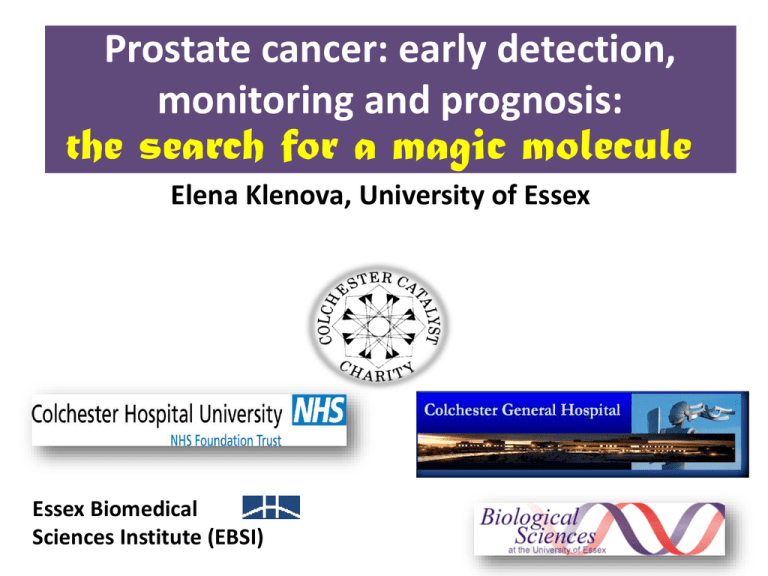
Prostate cancer: early detection,
monitoring and prognosis:
the search for a magic molecule
Elena Klenova, University of Essex
Essex Biomedical
Sciences Institute (EBSI)
Most Common Types of Cancers in Men
info.cancerresearchuk.org/.../males/index.htm
What is Prostate Cancer?
• Prostate Gland is a part of male reproductive system
• Risk Factors: Age, Family History, Diet
• Major Symptoms: Lower back pain, slow/
painful urination, blood in urine or semen
• Diagnosis:
PSA blood test (Prostate Specific Antigen)prostate cancer biomarker
DRE (Digital Rectal Examination)
• Treatment: Active Surveillance, Surgery,
radiation therapy,
hormonal therapy, chemotherapy
Prostate cancer - Facts
– Most cases of prostate cancer develop in
older men (over the age of 65)
– 35 000 cases diagnosed / year (UK)
– 10 000 deaths / year (UK)
– Second most common cause of cancer death
– More than 200 men are diagnosed with
Prostate Cancer at the Urology Department
(CHUFT) each year; 281 new cases in 2011
MAJOR ISSUES – match Prostate Cancer
UK there are three priority areas
1. Identifying men at highest risk of developing
clinically significant prostate cancer.
2. Distinguishing aggressive prostate cancer
from indolent disease. Understanding how
aggressive prostate cancers develop.
3. Finding new, targeted treatments for advanced
prostate cancer.
1-2 Prostate cancer development
and detection
• Slow growing and takes years before it is
detected.
• Does not always need to be treated.
• Only few patients have an aggressive form
of prostate cancer that grows much more
quickly.
• Currently it is hard to detect which form of
cancer a patient has, which can make prostate
cancer treatment decisions more difficult.
3. Treatment and its monitoring
Why Advanced Prostate Cancer Becomes
Resistant to Androgen-Deprivation Therapy?
New therapies?
Androgen-dependent
Androgen-Independent
The search for “MAGIC” molecules
specific for prostate cancer disease
• Useful as BIOMARKERS ( disease –specific markers)
for diagnosis and prognosis of a condition.
• Help to understand how aggressive cancer develop
and distinguish.
• Useful as targets for specific anti-prostate cancer
therapies.
BORIS- the solution to all three issues?
Zinc Fingers
Structure of
BORIS protein
1
2
3
4
5
6
7
8
9
N
10 11
C
DNA-binding region
BORIS: Brother Of the Regulator of Imprinted Sites
• Member of CTA (Cancer Testis Antigen) family - only
expressed in the testis, but not in other normal tissues.
• Aberrantly expressed in different malignancies, including
prostate cancer.
In press
AIM OF THE STUDY: investigate the
association of BORIS with prostate cancer
• Investigate BORIS expression in prostate tissues
obtained from patients with prostate cancer
• Correlate the BORIS results with clinical information
(Gleason Score, Tumour stage, Androgen Receptor
status)
• Can BORIS be the magic molecule ?
Recruitment Process
•
•
•
•
•
•
( coordinated by Zubair Cheema)
Patients with histological diagnosis of
Prostate Cancer (Sister Lucy Powell)
Patient Discussion and Consent pre op
Surgery at C.G.H. (Mr. Corr and Mr. Casey)
Tissue Transfer to Pathology
Tissue Assessment
(Dr. Ian Seddon)
Tissue frozen at stored
at UoE
Immuno Histochemistry
BORIS staining on Prostate Tumor Tissue Sections
IRS= 9
IRS= 8
IRS= 3
Non Tumor
BPH
Prostate Tumor
IRS=0
IRS=0
Secondary only
No BORIS staining was observed in non-tumor and BPH tissue sections
BORIS in prostate tumour tissues:
positive correlations with poor prognosis
Androgen Receptor (AR)
• Activated by binding of androgens (e.g. Testosterone).
• Essential for normal and abnormal growth of prostate.
• Higher levels of AR are often detected in more aggressive prostate
cancers
Happy
cell
mRNA
Production of
proteins to
support growth
of prostate cells
Clinical Correlation: BORIS and AR in
prostate tumors
Are the AR mRNA and protein levels affected by
BORIS
over-expression(+) or BORIS knock down(-)?
Plate cells
qPCR for
mRNA analysis
Add mix to the cells
Mix BORIS DNA/
BORIS siRNA
with
transfection
reagent
Incubate for 48 hrs and assay
To measure AR and BORIS
levels
Western blot assay
for protein analysis
BORIS positively regulated the AR gene
AR mRNA
AR and BORIS protein analysis
BORIS mRNA
BORIS positively regulated the AR
gene in prostate cancer cells
AR
Gene
AR
Gene
AR
Gene
Role of BORIS in the development of
more aggressive prostate cancer?
Androgen Receptor
(AR) is key for
prostate cancer
progression and then
development of the
independence from
androgens.
Androgendependent
AndrogenIndependent
Advanced Prostate
Cancer
Difficult to cure!
Conclusions
• BORIS is present in prostate tumor tissues but absent in
normal and Benign Prostate Hyperplasia (non-tumour)
tissues: BORIS is a marker for prostate cancers.
• A positive correlation exists between BORIS IRS and Gleason
Scoring /Tumor Stage: BORIS is a marker for poor prognosis
of prostate cancer.
• BORIS is an activator or the Androgen Receptor gene: BORIS
is associated with the development of more aggressive
prostate cancers.
• BORIS is present only in cancer cells and therefore is a very
attractive target for anti-tumour therapy.
BORIS - the “MAGIC” molecules specific
for prostate cancer disease?
• Useful as BIOMARKERS ( disease –specific markers)
for diagnosis and prognosis of a condition.
• Help to understand how aggressive cancer develop
and distinguish.
• Useful as targets for specific anti-prostate cancer
therapies.
Elena Fabiola Georgia Dawn
Jay
Svetlana Hulkar
Ola
Zubair
Anu
Adele
Krista Yukti
Clinical collaborators
Acknowledgements
Mr. J. Corr, Mr. R. Casey
Dr. I. Seddon, Sister Lucy Powel
Histopathology staff at C.G.H.
Funded by
Colchester Hospital University NHS
Colchester Catalyst Charity
University of Essex
Essex Biomedical
Sciences Institute (EBSI)
Western Blotting-BORIS protein levels
in prostate cancer cell lines and tumours
BORIS expression in prostate cell lines
BORIS in prostate tumours:
immunofluorescence staining








